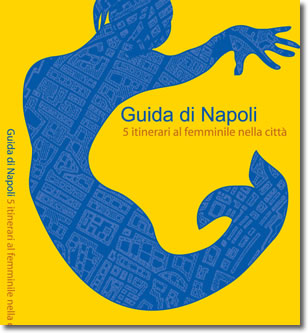

The "ParteNopea e ParteDonna" guide is a contribution to a view and to knowledge of the city of Naples from a different angle, an angle which throws into relief another face of the city, the impression left by the women who have taken part in every event of its history.
Using the same irony as the words of our great comedian Totò, visitors to the city are offered an unusual vision of the town, the city of Parthenope, whose spaces are associated with women personages, with that "women's angle" which has given them a different character. Only this new composition can fully restore the extraordinary wealth which is the real Naples.

In the history of Naples as it is usually told, in the history of the urban development as recounted , designed and proposed by the protagonists and winners in the struggle for political and economic power, we rarely find references to women's history.
Even descriptions of the town through its artistic and architectural history avoid mentioning women and certainly do not mention the women who have been protagonists of its history, with the exception ofallegorical feminine figures.
To give an idea of the city that involves women we need to look beyond the superficial structures, beyond the facades of monuments and look at the detail, the discrete, barely-visible traces. We need to step over the threshold, immerse ourselves in the places, relive events, free ourselves from the interfering traditional neutral perception, and begin to ask new questions .. if, that is, we wish to recognise the whole of the city's history.
Only if we observe the make-up of the town, its buildings, its streets, imagining the rich network of actions, alliances, passions, the actions and thoughts of men and women that these things embrace, can we see the other side of the coin.
We discover a universe of women who have lived and constructed here within the llimits of the possibilities of their action. For up until the 20th century they have not played a part of the decisional processes related to the structure of the town, except of course indirectly - they have not been able to operate asengineers, architects, sculptors, or workers contributing to building techniques. A great many women have not constructed the parts of the town in a material sense, but have created them with their ideas, their wealth, their knowledge. They have left more writings, objects,gestures, minute and ephemeral footprints than great lasting works. Their contributions have been documented and sent down to us in a discontinuous, fragmentary way in the form of anecdotes and biographies of famous women.
Much of their work has for a long time remained in the dark, considered to be of minor interest; much of it has simply been overlooked And so wgerever one looked, the traces of women that are all over the city have not been discovered- in the churches, the houses, on the political, intellectual and entertainment scenes. The extent to which women have moulded the Neapolitan scene has not been brought to general awareness.
In Naples too, as everywhere else, women have always "formed" the city, they have left their mark on its development and its appearance by their inspiration, creators and financiers, so contibuting to the architectural and cultural identity of the city.
In the historical buildings of Naples, the literary and political salons have been alive with women writers, patriots and philanthropists; in the institutes of art, music, in the museums, we find testimony to artists and musicians of great import, in the theatres all over the city there have been actresses and singers of great talent.
And wherever women are in action, they leave not only material, permanent, visible signs, but also the wealth of their emotions and passions for this city, marked always by their everyday presence.
Getting to know the city by following this alternative road, often barely visible, of women's subjectivity, becomes a revelation because it is only in this way that we can interpret thegreat legacy of human resources, not only physical, which have always characterised this city